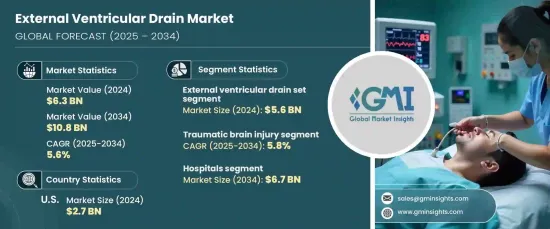
뇌실외배액(EVD) 세계 시장은 2024년에 63억 달러로 평가되었고 2025-2034년에 걸쳐 5.6%의 연평균 복합 성장률(CAGR)로 견조하게 확대될 것으로 예측하고 있습니다.
이러한 높은 성장은 신경 질환의 유병률 증가, 치료 옵션에 대한 의식 증가, 세계 의료 서비스에 대한 접근의 확대로 인한 것입니다.

시장을 견인하고 있는 부문은 주로 뇌실외배액 세트와 부속품 부문입니다. 2024년에는 EVD 세트가 시장을 주도하여 56억 달러의 상당한 수익을 창출했습니다. 이 세트는 의료 제공업체에게 완벽한 솔루션을 제공하고 치료 효율성을 높이며 조립 실수의 위험을 줄입니다. 올인원 EVD 세트는 개별 부품을 조달할 필요가 없으며, 특히 긴급 상황에서 탁월한 편의성을 제공합니다. 외상성 뇌손상 및 뇌졸중과 같은 신경학적 응급 상황의 빈도가 증가함에 따라 집중 치료실(ICU) 및 외상 센터에서 EVD 시스템에 대한 수요가 크게 증가하고 있습니다. 사용자 친화적인 디자인과 접근성은 중증 환자 관리 환경에서의 보급에 기여합니다.
| 시장 범위 | |
|---|---|
| 시작년 | 2024년 |
| 예측연도 | 2025-2034년 |
| 시작금액 | 63억 달러 |
| 예측금액 | 108억 달러 |
| CAGR | 5.6% |
뇌실외배액 시장은 병원, 외래수술센터(ASC), 기타 의료 시설 등 최종 용도별로 구분되어 있습니다. 2024년에는 병원이 주요 부문으로 부상했으며 2034년까지 67억 달러의 매출이 예상됩니다. 신경학적 응급 상황을 치료하는 주요 의료 환경으로서 병원은 외상성 뇌 손상, 뇌졸중, 두개내 출혈 등의 경우에 즉각적으로 개입하기 위해 EVD 시스템에 크게 의존합니다. 최첨단 진단 기술과 수술 기술을 갖춘 병원은 복잡한 신경 질환의 치료에 특히 적합하며 이는 EVD 장치 수요를 더욱 밀어올리고 있습니다. 첨단 집중 치료실(ICU)과 수술 시설은 치료 결과 향상에 매우 중요한 역할을 하고 있으며, 병원은 지속적으로 시장 성장의 중요한 원동력이 되고 있습니다.
미국의 뇌실외배액 시장은 2024년에 27억 달러를 달성하였고 2034년까지 연평균 복합 성장률(CAGR) 5%로 성장할 것으로 예측됩니다. 미국은 외상 센터 및 신경과 전문 병원의 광범위한 네트워크 외에도 첨단 의료 기술의 채용률이 높기 때문에 시장에서 우위를 차지하고 있습니다. 유리한 환급 정책과 R&D에 대한 많은 투자가 시장 확대에 더욱 기여하고 있습니다. 수두증 및 두개내 출혈 등 신경질환의 유병률 증가가 EVD 시스템 수요를 뒷받침하고 있으며 미국을 세계 시장의 주요 진입국으로 자리매김하고 있습니다.
The Global External Ventricular Drain Market was valued at USD 6.3 billion in 2024 and is anticipated to expand at a robust CAGR of 5.6% from 2025 to 2034. This impressive growth can be attributed to the increasing prevalence of neurological disorders, heightened awareness of treatment options, and greater access to healthcare services worldwide.

The market is primarily driven by external ventricular drain sets and accessories. In 2024, EVD sets dominated the market, generating a substantial USD 5.6 billion in revenue. These sets provide a complete solution for healthcare providers, enhancing procedural efficiency and reducing the risk of assembly errors. With their all-in-one design, EVD sets eliminate the need for sourcing individual components, offering unparalleled convenience, particularly in emergency situations. The rising frequency of neurological emergencies, including traumatic brain injuries and strokes, has significantly boosted the demand for EVD systems in intensive care units (ICUs) and trauma centers. Their user-friendly design and easy accessibility contribute to their widespread adoption in critical care environments.
| Market Scope | |
|---|---|
| Start Year | 2024 |
| Forecast Year | 2025-2034 |
| Start Value | $6.3 Billion |
| Forecast Value | $10.8 Billion |
| CAGR | 5.6% |
The external ventricular drain market is also segmented by end-use, including hospitals, ambulatory surgical centers, and other healthcare facilities. In 2024, hospitals emerged as the leading segment, with expectations to generate USD 6.7 billion by 2034. As the primary healthcare setting for treating neurological emergencies, hospitals rely heavily on EVD systems for immediate intervention in cases like traumatic brain injuries, strokes, and intracranial hemorrhages. Equipped with state-of-the-art diagnostic and surgical technologies, hospitals are particularly well-suited to handle complex neurological conditions, further propelling the demand for EVD devices. Advanced intensive care units (ICUs) and surgical facilities play a pivotal role in improving procedural outcomes, ensuring that hospitals continue to be a significant driver of market growth.
The U.S. external ventricular drain market accounted for USD 2.7 billion in 2024 and is projected to grow at a CAGR of 5% through 2034. The U.S. holds a dominant position in the market due to its extensive network of trauma centers and specialized neurology hospitals, combined with high adoption rates of advanced medical technologies. The favorable reimbursement policies and significant investments in research and development further contribute to the market's expansion. The increasing prevalence of neurological conditions such as hydrocephalus and intracranial hemorrhages continues to fuel the demand for EVD systems, solidifying the U.S. as a key player in the global market.